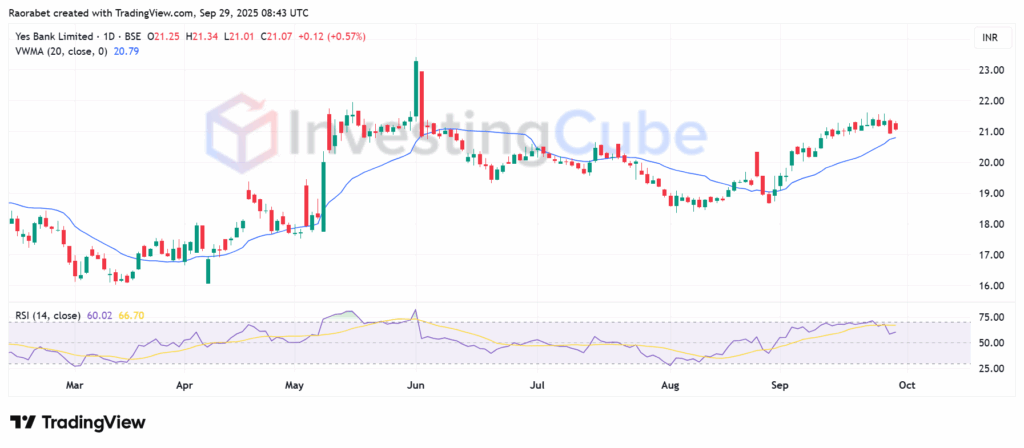- Yes Bank share price has risen steadily since late August amid improved investor confidence, but multiple hurdles could reverse gains.
Yes Bank share price has been going up steadily during the past month, from late August to late September 2025. In that period, it has risen from around ₹19 to about ₹21, which is a rise of about 11%. This recent rise is mostly due to major strategic investment and better fundamental indicators. However, a closer look shows that the bank’s turnaround is going well, but there is still a significant amount of risk on the road ahead.
Why is Yes Bank Stock Rising?
The primary propulsion behind Yes Bank share price rise is the move by Japanese banking giant Sumitomo Mitsui Banking Corporation (SMBC) to raise its investment. SMBC bought a 24.2% interest in Yes Bank for about ₹16,000 crore (approximately $1.8 billion). This gave them two seats on the board and gave the Indian private bank the money it needed to continue with its turnaround.
The Reserve Bank of India (RBI) approved this move in late August, igniting investor confidence. The move by RBI also demonstrated that Yes Bank’s turnaround story has captured attention outside of India.
Yes Bank (BSE: YESBANK) wants to use SMBC’s global strength, especially to make it easier for businesses in India and Japan to trade and invest with each other. This should help its corporate banking, treasury services, and cross-border operations.
In addition to the SMBC financial injection, Yes Bank’s improved financial base has been a big part of its recent success. The bank’s net profit rose 63.3% year over year to ₹738.1 crore in Q4 FY25. This was due to higher asset quality and fewer non-performing assets (NPAs). Strong expansion in lending, especially in areas like used car loans and low-cost loans, has helped bring in more money.
Is the Rise Sustainable?
The recent rise in Yes Bank share price is less about the initial excitement about the SMBC deal and more about the bank’s capacity to turn this support into long-term financial success. The SMBC investment could lead to a higher credit rating than the present AA-. In turn, that could bring in more institutional deposits and cut the cost of borrowing.

Yes Bank share price is on a strong upside momentum with the daily RSI at 60 and the stock well above the Volume Weighted Moving Average (VWMA). Chart Source: TradingView
But for the rally to last, Yes Bank needs to show that its fundamental operating indicators are improving significantly over the next few quarters. Non-Performing Assets (NPAs) are going down, but the bank needs more low-cost Current Account and Savings Account (CASA) deposits to raise its Net Interest Margin, which is now lower than the industry average. Achieving profitable lending growth requires resolving the long-standing issue of slow deposit growth.
What Are the Risks?
The sluggish rate of complete fundamental recovery is still the key challenge. Also, while the bank’s profits have gone up, they are still modest relative to the bank’s market capitalization and the profits of its larger, more successful competitors.
Challenges in operations, such as competition from fintechs and bigger peers, could slow progress. Also, the SMBC merger is a good thing, but any problems with integration or dilution effects could hurt short-term performance. Furthermore, changes in the regulatory environment, such stricter RBI rules on capital or lending, might hurt margins.
In Summary
To sum up, the recent uptick by Yes Bank share price is due to smart investments and improved operational performance. If the economy stays stable, this is a good sign for the future. That said, investors should carefully consider the risks, spread their money around, and keep an eye on changes in the law.
Yes Bank shares are rising on news of increased stake by SMBC, improved earnings, and strong technical momentum driving investor confidence.
Sustainability by the stock depends on the bank delivering consistent improvement in core fundamentals, such like higher profitability and stronger deposit growth.
Risks includes market volatility, regulatory pressures, economic shifts, low return on equity and tight competition within the Indian fintech market.
This article was originally published on InvestingCube.com. Republishing without permission is prohibited.


